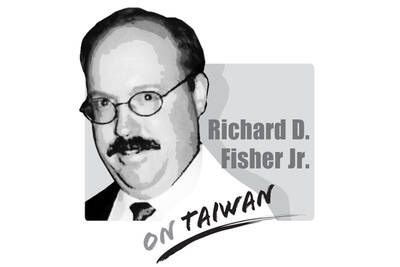I first visited Taiwan in 1985, when I was deputed by His Holiness the Dalai Lama to start a dialogue with the Chinese Nationalist Party (KMT).
I spent three days talking to officials, the end result being the signing of an agreement where the Republic of China (ROC) recognized the right to self-determination of Tibetans.
According to official KMT records in Nanking, Tibet never paid taxes to the ROC government.
In 1997, the Dalai Lama made his first ever visit to Taiwan on the invitation of then-president Lee Teng-hui (李登輝). Lee took the bold step of opening Taiwan’s doors to His Holiness. The visit was most successful and changed the attitude of His Holiness toward Taiwanese.
His Holiness asked me what I thought of his visit and I advised him saying that, as this was his first visit ever to a “Han territory,” it was historical, and if he was successful in Taiwan he would be successful in China.
After seeing Taiwan’s robust democracy, His Holiness recognized Taiwanese as a separate entity to Chinese.
Later that year I visited Taipei to start grassroots lobbying for Tibetan issues. On one occasion I met then-Taipei mayor Chen Shui-bian (陳水扁), who was quite upset, as he had not been given an audience with His Holiness during his visit. As mayor, Chen issued an invitation to His Holiness, which His Holiness accepted when Chen was president.
In a breakfast meeting with former American Institute in Taiwan director James Lilley and then-Democratic Progressive Party (DPP) chairman Hsu Hsin-liang (許信良), the latter asked Lilley whether he thought China would ever fire missiles toward Taiwan. Lilley turned toward me and said: “Why don’t we ask our Tibetan friend?” I retorted by giving the example of the Chinese invasion of Tibet in 1950, where they used modern weapons against us Tibetans.
I have always felt the DPP was good in opposition politics, but never had any idea of China’s brutal tactics and how to defend Taiwan.
One issue which I found disturbing was national identity. In the 1990s there were two distinct camps: Mainlanders and local residents. Today this has evolved as young people in Taiwan identify themselves as Taiwanese.
After Typhoon Morakot, which caused widespread death and destruction, His Holiness was invited to Taiwan and the KMT government issued him a visa on condition he did not make any political statements.
President Tsai Ing-wen (蔡英文) in her first term became the only DPP president not to issue a visa to the Dalai Lama upon his request to visit Taiwan.
After 30 years in Taiwan I admire the way democracy has become vibrant, but I wonder whether Taiwanese have the will to stand up to the People’s Republic of China (PRC).
“One country two systems,” which was started in Tibet and failed in Hong Kong, has come and gone. What is now left for the PRC is the use of brute force: They have suppressed Tibet, then Hong Kong and are now using strong-arm tactics on Taiwan.
I believe Taiwanese democracy will survive, but Taiwanese have to stand up for themselves first.
Khedroob Thondup is a former member of the Tibetan parliament in exile.
We are used to hearing that whenever something happens, it means Taiwan is about to fall to China. Chinese President Xi Jinping (習近平) cannot change the color of his socks without China experts claiming it means an invasion is imminent. So, it is no surprise that what happened in Venezuela over the weekend triggered the knee-jerk reaction of saying that Taiwan is next. That is not an opinion on whether US President Donald Trump was right to remove Venezuelan President Nicolas Maduro the way he did or if it is good for Venezuela and the world. There are other, more qualified

This should be the year in which the democracies, especially those in East Asia, lose their fear of the Chinese Communist Party’s (CCP) “one China principle” plus its nuclear “Cognitive Warfare” coercion strategies, all designed to achieve hegemony without fighting. For 2025, stoking regional and global fear was a major goal for the CCP and its People’s Liberation Army (PLA), following on Mao Zedong’s (毛澤東) Little Red Book admonition, “We must be ruthless to our enemies; we must overpower and annihilate them.” But on Dec. 17, 2025, the Trump Administration demonstrated direct defiance of CCP terror with its record US$11.1 billion arms
China’s recent aggressive military posture around Taiwan simply reflects the truth that China is a millennium behind, as Kobe City Councilor Norihiro Uehata has commented. While democratic countries work for peace, prosperity and progress, authoritarian countries such as Russia and China only care about territorial expansion, superpower status and world dominance, while their people suffer. Two millennia ago, the ancient Chinese philosopher Mencius (孟子) would have advised Chinese President Xi Jinping (習近平) that “people are the most important, state is lesser, and the ruler is the least important.” In fact, the reverse order is causing the great depression in China right now,
As technological change sweeps across the world, the focus of education has undergone an inevitable shift toward artificial intelligence (AI) and digital learning. However, the HundrED Global Collection 2026 report has a message that Taiwanese society and education policymakers would do well to reflect on. In the age of AI, the scarcest resource in education is not advanced computing power, but people; and the most urgent global educational crisis is not technological backwardness, but teacher well-being and retention. Covering 52 countries, the report from HundrED, a Finnish nonprofit that reviews and compiles innovative solutions in education from around the world, highlights a